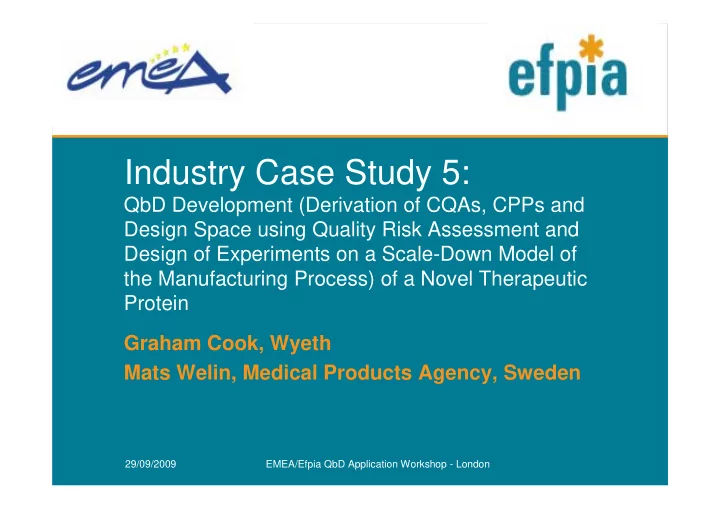

Industry Case Study 5: QbD Development (Derivation of CQAs, CPPs and Design Space using Quality Risk Assessment and Design of Experiments on a Scale-Down Model of the Manufacturing Process) of a Novel Therapeutic Protein Graham Cook, Wyeth Mats Welin, Medical Products Agency, Sweden 29/09/2009 EMEA/Efpia QbD Application Workshop - London
Case Study Case Study Summary - 1 • Introduction to project – QbD applied to Drug Substance – Monoclonal antibody in Phase 3 development – CHO cell manufacturing process • Defining the QTPP and Drug Substance CQAs – Quality Risk Assessment approach to identify potential CQAs was described – Outline presented of Structure-Activity Relationship (SAR) studies to understand attributes with unknown impact to severity or limited knowledge – SAR studies ongoing 2 29/09/2009 EMEA/Efpia QbD Application Workshop - London
Case Study Case Study Summary - 2 • Scale-down models – Approach to development of scale-down model was described briefly – Data was presented to show equivalent performance across multiple scales – Valid scale-down model used for process characterization • Upstream and downstream process characterization – Approach to characterization of the cell culture and purification processes was described: • Quality Risk Assessment and initial screening studies to identify potential CPPs • Multivariate DoE to develop response surfaces and design space • Linkage between certain unit operations explored – Graphical examples of response surfaces / design space presented 3 29/09/2009 EMEA/Efpia QbD Application Workshop - London
Case Study Case Study Summary - 3 • Developing process understanding, design space and control strategy for the HMW CQA – mAb species with potential to form HMW aggregate – Experimental investigation of phenomenon described, including development and use of an analytical tool – Process understanding used to refine scale-down model and adjust large scale process – Process understanding used to develop a design space for bioreactor • Summary - Learnings – QbD principles for large and small molecules the same – QbD goal is product and process robustness and enhanced QA – Scale-down models important to develop process understanding 4 29/09/2009 EMEA/Efpia QbD Application Workshop - London
Main Topics Discussed - 1 Technical Discussions: – How do you feedback large scale experience into scale-down models? • e.g. refinement of models based on large scale experience – How can a company show that ‘all’ factors have been considered during development and establishment of the manufacturing process? • How have interactions been taken into consideration? – How are other factors combined into the design space e.g. developing a combined design space for several CQAs? • Need to demonstrate the effects of the CPPs on other CQAs if a design space for a single CQA is illustrated – How was the risk ranking process conducted - e.g. setting thresholds, and scoring? 5 29/09/2009 EMEA/Efpia QbD Application Workshop - London
Main Topics Discussed - 2 Preparation and Review of Dossiers and Inspections: – In which way will the new tools will help manage changes or improvements to biologics? – Would non-critical attributes and parameters be discussed in the submission? What commitments would be made for e.g. trending? – Would the approach to inspections change with a biologic developed using QbD principles? 6 29/09/2009 EMEA/Efpia QbD Application Workshop - London
Common Understanding - 1 • Understanding of the application of QbD to biologics has advanced • Design spaces for biologics can be registered and movement within the design space can be managed within the company’s quality system • Need for industry to continue to define, justify and focus on CQAs/CPPs AND provide rationale for non-critical attributes and parameters • Certain non-critical attributes/parameters may be monitored without regulatory commitments e.g. fixed limits • Data from scale-down models are important to define and understand the process – Needs to be predictive and applicable to large scale manufacture 7 29/09/2009 EMEA/Efpia QbD Application Workshop - London
Common Understanding - 2 • Data summaries for small scale characterisation studies should be presented in the dossier and at time of inspection – Limited time available to reviewers and inspectors means that concise, well-explained overviews are required, with enough data to support conclusions • Approaches to inspections may not change substantially – Still doing a GMP inspection with similar focus on quality systems – Assessors may join inspectors for more complex submissions • Design space maintenance requires knowledge management – Continuous feedback of experience, including iterative quality risk management, gained at both large scale and small scale – Maintain through robust change management process 8 29/09/2009 EMEA/Efpia QbD Application Workshop - London
Areas for further Discussions • Are data coming only from scale-down models sufficient for justification of changes? • How could different equipment be included in a design space e.g. disposable bioreactors? • How to use prior knowledge to facilitate further planned changes? – e.g. inclusion of protocol describing approach in original submission (similar to approach for Stability studies) • Presentation of design space, in a way that makes it easily understandable, where there may be >3 parameters impacting several CQAs 9 29/09/2009 EMEA/Efpia QbD Application Workshop - London
Recommend
More recommend